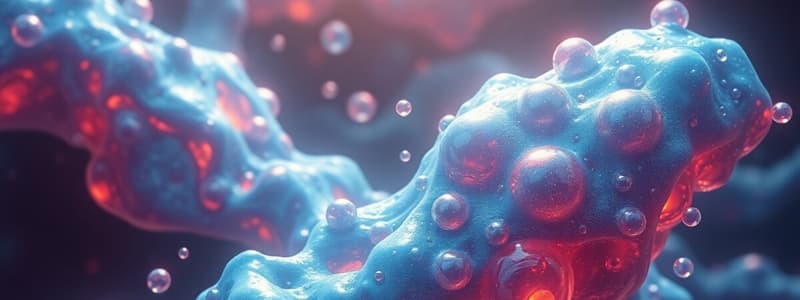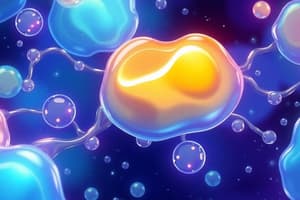Podcast
Questions and Answers
Lipids are exclusively found in animals and are not present in plants.
Lipids are exclusively found in animals and are not present in plants.
False (B)
Lipids are highly soluble in water but insoluble in organic solvents.
Lipids are highly soluble in water but insoluble in organic solvents.
False (B)
Simple lipids include phospholipids and glycolipids.
Simple lipids include phospholipids and glycolipids.
False (B)
Saturated fats help lower blood cholesterol levels.
Saturated fats help lower blood cholesterol levels.
Oils are solid at room temperature, while fats are liquid at room temperature.
Oils are solid at room temperature, while fats are liquid at room temperature.
Fats and oils are composed of fatty acids and two molecules of glycerol, forming diglycerides.
Fats and oils are composed of fatty acids and two molecules of glycerol, forming diglycerides.
Fatty acids consist of chains of carbon atoms ranging from 100-500 in length, with a hydroxyl group on the end.
Fatty acids consist of chains of carbon atoms ranging from 100-500 in length, with a hydroxyl group on the end.
A fatty acid is considered saturated if it contains one or more double bonds between carbon atoms.
A fatty acid is considered saturated if it contains one or more double bonds between carbon atoms.
Fats and oils contain carbon hydrogen and sulfur
Fats and oils contain carbon hydrogen and sulfur
One gram of typical fat yields about 20 Kcal of heat when completely combusted, compared to about 4.15 Kcal for a typical carbohydrate.
One gram of typical fat yields about 20 Kcal of heat when completely combusted, compared to about 4.15 Kcal for a typical carbohydrate.
Oils found in plant seeds are generally diglycerides.
Oils found in plant seeds are generally diglycerides.
For acetic acid, 'C 4' in its abbreviated designation means that it contains four carbon atoms.
For acetic acid, 'C 4' in its abbreviated designation means that it contains four carbon atoms.
Linoleic acid is an unsaturated fatty acid with the abbreviated designation C 18:4.
Linoleic acid is an unsaturated fatty acid with the abbreviated designation C 18:4.
Fats are included in animal diets primarily to provide a source of water-soluble vitamins.
Fats are included in animal diets primarily to provide a source of water-soluble vitamins.
In adult ruminant diets, the fat supplement percentage should typically exceed 15%.
In adult ruminant diets, the fat supplement percentage should typically exceed 15%.
A high-fat ration always increases feed intake in animals.
A high-fat ration always increases feed intake in animals.
Young animals receiving a high level of milk in their diet typically get 5-10% fat.
Young animals receiving a high level of milk in their diet typically get 5-10% fat.
Ruminants are generally more tolerant of high-fat diets than non-ruminants.
Ruminants are generally more tolerant of high-fat diets than non-ruminants.
Feeding 'protected fats' can help overcome the adverse effects of high lipid intake in monogastric animals.
Feeding 'protected fats' can help overcome the adverse effects of high lipid intake in monogastric animals.
The process of protecting fats involves encapsulating large droplets of oils in a thick layer of starch.
The process of protecting fats involves encapsulating large droplets of oils in a thick layer of starch.
Protected fats are designed to be attacked by microorganisms in the rumen, enhancing digestion efficiency.
Protected fats are designed to be attacked by microorganisms in the rumen, enhancing digestion efficiency.
Feeding of unsaturated fat in protected form decreases the degree of unsaturation of plasma lipids, milk and body fat.
Feeding of unsaturated fat in protected form decreases the degree of unsaturation of plasma lipids, milk and body fat.
The connection between human diseases and the intake of unsaturated fat is widely accepted and uncontroversial.
The connection between human diseases and the intake of unsaturated fat is widely accepted and uncontroversial.
Omega-3 fatty acids are known to enhance the atherogenic process in humans.
Omega-3 fatty acids are known to enhance the atherogenic process in humans.
Freshwater fish typically have higher content of omega-3 fatty acids compared to marine fish.
Freshwater fish typically have higher content of omega-3 fatty acids compared to marine fish.
The omega-3 fatty acid content in fish is consistent across species and is unaffected by factors like diet and water temperature.
The omega-3 fatty acid content in fish is consistent across species and is unaffected by factors like diet and water temperature.
Omega-3 fatty acids work to elevate total serum lipids and cholesterol.
Omega-3 fatty acids work to elevate total serum lipids and cholesterol.
The inclusion of fish meal or full-fat linseed in the diet of laying hens can decrease the omega-3 fatty acid content of their eggs.
The inclusion of fish meal or full-fat linseed in the diet of laying hens can decrease the omega-3 fatty acid content of their eggs.
Omega-3 fatty acids are essential dietary components for dogs but not fish.
Omega-3 fatty acids are essential dietary components for dogs but not fish.
Fat digestion and absorption are similar to that of carbohydrates and proteins, as all are miscible with water.
Fat digestion and absorption are similar to that of carbohydrates and proteins, as all are miscible with water.
Bile and gastric protease are the primary factors in fat digestion within simple-stomached animals.
Bile and gastric protease are the primary factors in fat digestion within simple-stomached animals.
During absorption in simple-stomached animals, the majority of lipids are absorbed as triglycerides.
During absorption in simple-stomached animals, the majority of lipids are absorbed as triglycerides.
In ruminants, the digestion of lipids primarily yields acetic acid instead of propionic acid.
In ruminants, the digestion of lipids primarily yields acetic acid instead of propionic acid.
In ruminants, the digestion of lipids primarily and directly results in monoglycerides.
In ruminants, the digestion of lipids primarily and directly results in monoglycerides.
In ruminants, bacteria and protozoa in the rumen synthesize fatty acids for their own cell lipids, including acids with only even numbers of carbon atoms.
In ruminants, bacteria and protozoa in the rumen synthesize fatty acids for their own cell lipids, including acids with only even numbers of carbon atoms.
Flashcards
What are Lipids?
What are Lipids?
Organic compounds found in plants and animals, extractable by fat solvents.
Lipid Classification
Lipid Classification
Lipids are classified into saponifiable (simple, compound) and nonsaponifiable lipids.
Fats vs. Oils
Fats vs. Oils
Fats are generally solid at room temperature (25°C), while oils are liquid at the same temperature.
Composition of Fats and Oils
Composition of Fats and Oils
Signup and view all the flashcards
Saturated Fatty Acid
Saturated Fatty Acid
Signup and view all the flashcards
Unsaturated Fatty Acid
Unsaturated Fatty Acid
Signup and view all the flashcards
Energy from Fats
Energy from Fats
Signup and view all the flashcards
Plant Seed Oils
Plant Seed Oils
Signup and view all the flashcards
Acetic Acid
Acetic Acid
Signup and view all the flashcards
List of Unsaturated Fatty Acids
List of Unsaturated Fatty Acids
Signup and view all the flashcards
Why fats are a necessity?
Why fats are a necessity?
Signup and view all the flashcards
What are Protected Fats?
What are Protected Fats?
Signup and view all the flashcards
Benefits of Rumen-Protected Fats
Benefits of Rumen-Protected Fats
Signup and view all the flashcards
Effect of Feeding Protected Unsaturated Fat
Effect of Feeding Protected Unsaturated Fat
Signup and view all the flashcards
Omega-3 Fatty Acids Benefits
Omega-3 Fatty Acids Benefits
Signup and view all the flashcards
Omega-3 Source
Omega-3 Source
Signup and view all the flashcards
How Omega-3 Works
How Omega-3 Works
Signup and view all the flashcards
Increasing Omega-3 in Feed
Increasing Omega-3 in Feed
Signup and view all the flashcards
Omega-3 for Fish
Omega-3 for Fish
Signup and view all the flashcards
Fat Digestion Differences
Fat Digestion Differences
Signup and view all the flashcards
Simple-Stomached Fat Digestion
Simple-Stomached Fat Digestion
Signup and view all the flashcards
Form of Absorption
Form of Absorption
Signup and view all the flashcards
Lacteals and Absorption
Lacteals and Absorption
Signup and view all the flashcards
Ruminant VFA source
Ruminant VFA source
Signup and view all the flashcards
Rumen Microbes
Rumen Microbes
Signup and view all the flashcards
Why lipids are passed along?
Why lipids are passed along?
Signup and view all the flashcards
Where are fats absorbed
Where are fats absorbed
Signup and view all the flashcards
Study Notes
- Lipids are organic compounds found in plants and animals
- Lipids include all substances extractable from biological materials with typical fat solvents
- Lipids are insoluble in water but soluble in organic solvents like benzene, ether, chloroform, carbon tetrachloride, and acetone
Lipid Classification
- Lipids can be classified as saponifiable or non-saponifiable
- Saponifiable lipids include simple and compound lipids
- Simple lipids include fats & oils and waxes
- Compound lipids include phospholipids, sphingolipids, glycolipids, and lipoproteins
- Non-saponifiable lipids include steroids, prostaglandins, fat-soluble vitamins, and trepenes
Types of Fat
- Unsaturated fats are "good" fats that help lower blood cholesterol
- Sources of unsaturated fats include fish, nuts, seeds, and oils from plants, avocados, olives, walnuts, and liquid vegetable oils like soybean, corn, and sunflower
- Saturated fats are "bad" fats that raise cholesterol
- Sources of saturated fats include beef, beef fat, veal, lamb, pork, lard, poultry fat, butter, cream, milk, cheeses, and other dairy products
- Trans fats are "very bad" fats that raise cholesterol and increase the risk of heart disease
- Sources of trans fats include vegetable shortenings, some margarines, crackers, cookies, and snack foods
Fats and Oils
- Fats are solid at room temperature (25°C), while oils are liquid at the same temperature
- Lipids from animal sources are usually solids (fats), and those from plant origins are usually liquids (oils)
- In animal nutrition, both fats and oils are generally referred to as fats
- Fats and oils are composed of fatty acids and one molecule of glycerol (mono-, di-, triglycerides)
- Fatty acids consist of chains of carbon atoms (2-24 or more) with a carboxyl group on the end
- If all available positions on carbon atoms are occupied by hydrogen, it is a saturated fatty acid; otherwise, it is unsaturated
- Fats contain the elements carbon, hydrogen, and oxygen, but are much higher in carbon and hydrogen
- 1 gram of typical fat yields about 9.45 Kcal of heat when completely combusted, compared to about 4.15 Kcal for a typical carbohydrate
- Oils found in plant seeds are generally triglycerides, while forages contain a high percentage of diglycerides with a galactose molecule attached to glycerol (galactolipids)
- Branched-chain fatty acids and those with an odd number of carbon atoms are often produced by microorganisms
- Ruminant animals' body fats may contain substantial amounts of such fatty acids
- Abbreviated designation for fatty acids indicates carbon atoms and double bonds
- C 2:0 means contains 2 Carbon atoms and no double bonds
- Examples of saturated acids are acetic (C 2:0), propionic (C 3:0), butyric (C 4:0), caproic (C 6:0), myristic (C 14:0), palmitic (C 16:0), stearic (C 18:0), arachidic (C 20:0), lignoceric (C 24:0)
- Examples of unsaturated acids are palmitoleic (C 16:1), oleic (C 18:1), linoleic (C 18:2), linolenic (C 18:3), arachidonic (C 20:4)
- Practical diets for farm animals, particularly poultry, need small amounts of fats for transport and fat-soluble vitamin absorption; source of essential fatty acids; increasing energy concentration
- Common fat sources are tallow, soybean oil, and byproducts of edible oil refining.
Fat Supplement in Diet
- Fat supplement percentages in animal diets vary
- Poultry: 5-10%
- Adult ruminant: 3-5% (6-8% for dairy cattle)
- Non-ruminant: 10-15%
- Too much fat can reduce feed intake, increase scouring, and render calcium and magnesium insoluble, leading to excretion in feces
- Young animals on high milk diets get 25-40% fat (desirable for their age)
- Ruminants on dry feed are less tolerant of high fat (not more than 6-8%)
- Above 10% lipid intake reduces rumen microbes' activities and retards carbohydrate fermentation and can be overcome by feeding protected fats
Protected Fats
- Fats are protected via encapsulation of small oil droplets in a thin layer of formaldehyde-treated protein (casein)
- Protection avoids microorganism attacks in the rumen
- Acidity in the abomasum releases the fat, which is available for digestion and absorption in the small intestine
Rumen-Active Oil vs Rumen-Protected Fat Supplements
- Rumen-active oil kills rumen bacteria, reduces fiber digestion, and produces trans-fatty acids which leads to milk fat depression
- Rumen-protected fat supplements avoid negative effects on fiber digestion and milk fat-reducing trans fats in the rumen
- Major groups of rumen-protected fats are saturated fatty acids (e.g. hydrogenated/fractionated) with high melting points
- Major groups of rumen-protected fats are calcium salts of palm oil (Megalac)
- Feeding unsaturated fat in protected form raises unsaturation in plasma lipids, milk, and body fat
- This is beneficial in preventing heart diseases and atherosclerosis
- The connection between saturated fat intake and human diseases is controversial; unsaturated milk has a poor shelf-life
Omega-3 and Omega-6 Fatty Acids
- Fish oils have a protective effect against atherogenesis due to polyunsaturated fatty acids (Omega-3 FAs) such as linolenic acid (C 18:3), eicosapentaenoic acid (EPA) (C 20:5), and docosahexaenoic acid (DHA) (C 22:6)
- Marine fish have higher omega-3 content than freshwater fish
- The content varies with species, season, water temperature, and the fish's diet
- Omega-3 FAs lower total serum lipids and cholesterol while modulating arachidonic acid conversion to prostaglandins
- Feeding laying hens two feed ingredients can produce omega-3 FAs-enriched eggs ("designer eggs")
- Omega-3 products can be increased using fish meal or full-fat linseed, a primary plant source of omega-3 FAs such as linolenic acid acceptable to consumers and healthy for avoiding disease
- Omega-3 FAs are dietary essentials for fish
- Omega-3 deficiency in fish leads to poor growth, liver and heart lesions, and shock syndrome
- For dogs, omega-3 and omega-6 FAs are essential for preventing and treating dermatitis
Digestion and Absorption of Fats
- Fat digestion and absorption differ from carbs or protein due to the non-polar, water-immiscible nature of fats
- Lipid digestion arranges lipids into a water-miscible form for absorption through small intestine microvilli
Fat Digestion in Simple-Stomached Animals
- Site: small intestine
- Digestion occurs through the action of bile (emulsifies fat, increasing surface area) and pancreatic lipase (hydrolyzes FAs from glycerol)
- Gastric lipase exists, but it is rather low
- Some diglycerides are absorbed, but the majority of absorption as monoglycerides and fatty acids
- The majority of long-chain FAs are absorbed by lacteals into the lymph system, entering the bloodstream near the vena cava vein
Fat Digestion in Ruminants
- Galactose is fermented to volatile FAs (absorbed through rumen walls)
- Fats hydrogenated (saturated)
- Yields mainly propionic acid, which is absorbed
- Glycerol and free FAs are yielded
- Bacteria and protozoa (rumen microbes) synthesize FAs for their lipids using acids with branched chains and odd numbers (13, 15, and 17 carbons)
- Microbial cells + hydrolyzed, hydrogenated lipids
- Lipids pass from rumen to abomasum, and protozoa disintegrate
- In the small intestine, triglycerides are hydrolyzed by pancreatic lipase, and monoglycerides and FAs are absorbed as in non-ruminants
- Triglycerides and phospholipids are resynthesized in the intestinal mucosa
Studying That Suits You
Use AI to generate personalized quizzes and flashcards to suit your learning preferences.




